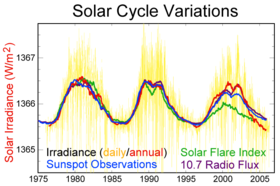-By Kevin Roeten
Can believing the earth is not a closed system hurl non-technical people down the forsaken path of anthropogenic global warming? Physics tells us that there are 3 types of systems: a closed system (cannot exchange matter, but can exchange heat), an isolated system (exchanges nothing), and an open system (exchanges everything). The earth, therefore, IS a closed system, because no matter is exchanged, but heat can be.
If no matter can be exchanged, nitrogen, oxygen, carbon, and all other elements will remain in the same quantities for the millions of years earth exists. With a finite amount carbon and oxygen, there will always be a finite amount of CO2. As a result, both warming and cooling of the earth takes place, and is partially explained by this video on Solar Variation.
On page 35, in the Climategate Book – Brian Sussman – Exposing Global Warming Scam, practically decapitates Michael Mann’s infamous “hockey stick”. Inserted in a Nature #392 (1998 edition), Mann had a bogus graph that had temperature with the stick positioned horizontally, and the blade pointing straight up. It was a popular method to convince the public the earth was in trouble with CO2-produced temperatures going through the roof.
In Climate during the Carboniferous Period (2), CO2 concentration has historically been much higher than today’s 400 ppm. For example, during the Jurassic Period (200 MYA), average CO2 concentration was about 1800 ppm, or almost 5x higher than today. The highest concentrations during all of the Paleozoic Era occurred during the Cambrian Period, at nearly 7000 ppm. That’s about 17x today’s 400 ppm.
In fact, if there was any rise in CO2, most climatologists actually point to a rise in earth temperatures proceeding any rise in CO2 levels by 400-1000 years. (1) [Brian Sussman, Climategate, New York: WND Books, 2010, p 75]
Sunspots, areas of solar unrest described in Solar Variation, are a distinct factor for climate change on earth. Through the 1930s the most persistent advocate of a solar-climate connection was Charles Greeley Abbot (Smithsonian Astrophysical Observatory). Sunspot variations were believed to be a huge reason for climate changes.
Sunspot numbers over the past 11,400 years have been calculated. The level of solar activity during the past 70 years is exceptional — the last period of similar magnitude occurred over 8,000 years ago. The sun was at a similarly high level of magnetic activity for approximately 10% of the past 11,000 years. Almost all of the earlier high-activity periods were shorter than the present episode.[27]
Sunspot cycles are numerous (3). Listed, they are: a) Schwabe 11 year cycle, b) Hale cycle (every 22 years the magnetic field of the sun reverses, so magnetic poles return to same state after two reversals), c) Gleissberg cycle (80-90 years; amplitude modulation of Schwabe Cycle), d) Suess cycle (every 210 years), e) Halstatt cycle (every 2300 years), and f) Xapsos cycle (every 6000 years).
The production of carbon-14 also is related to solar activity. Carbon-14 is produced in the upper atmosphere when cosmic ray bombardment transforms carbon into an unusual isotope with an atomic weight of “14” rather than the more common “12”.
Looking at the carbon-14 record, one could see that it too matched a pattern of climate change. One could connect the sunspot observations with the carbon-14 record, giving new doubts about solar stability. Because carbon-14 cycles are quasi-periodic, (Damon and Sonnet, 1989), those cycles can predict future climate[37]. Other patterns have been detected as well in its production every 105, 131, 232, 385, 504, 805, and 2,241 years (Damon and Sonnett, 1991).
The solar magnetic field, UV radiation (causes higher ozone production, leading to stratospheric heating and to pole-ward displacements in the stratosphere and troposphere wind systems), cloud formation by sun’s cosmic rays, solar flares (proton event), galactic cosmic rays (GCRs), and other features can easily affect climate rise and fall, along with the sunspot number.
Total solar irradiance, or insolation, is shown on the recent graph [http://en.wikipedia.org/wiki/Solar_variation].
One composite of the last 30 years of solar variability
CO2 accounts for less than 1% of gases in earth’s atmosphere; but only 3% of that sliver is due to man. (4)[Brian Sussman, Climategate, New York: WND Books, 2010, p.55]
It seems that earth cannot exchange matter, but can exchange heat. But we all know it exchanges heat with the sun, and is a closed system. The sun, however, has nothing to do with being anthropogenic.
1) Sussman, Brian. Climategate. New York: WND Books, 2010, p 75
2) Scotese, Christopher. “Plant Fossils of West Virginia”. Climate and the Carboniferous Period. 21 Mar. 2009. Paleomap Project
3) http://www.Solar variation_-_Wikipedia,_the_free_encyclopedia/
4) Sussman, Brian. Climategate. New York: WND Books, 2010, p 55
______
Kevin Roeten has written columns for over 10 years, after being a Chemical Engineer with Dupont for 20. A devout Catholic and staunch conservative, he loves to marry the ‘third rail’ of religion and politics into many of his articles.
Kevin Roeten can be reached at roetenks@charter.net.


Comments are closed.